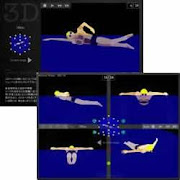 Jennifer Figge is currently somewhere west of the Cape Verde Islands off the coast to Africa swimming towards Barbados on her 3,380 kilometers (2,100 miles) odyssey across the Atlantic Ocean. According to her manager David Higdon, Jennifer and her support crew aboard the Carried Away have encountered significant storms throughout the initial stretch of their adventure.
Jennifer Figge is currently somewhere west of the Cape Verde Islands off the coast to Africa swimming towards Barbados on her 3,380 kilometers (2,100 miles) odyssey across the Atlantic Ocean. According to her manager David Higdon, Jennifer and her support crew aboard the Carried Away have encountered significant storms throughout the initial stretch of their adventure. Winds of 25 knots and waves as high as 30 feet have wreaked havoc with their movements and Jennifer's swimming. Fish are flying everywhere, including onto and into the boat and cabins. As a result, Jennifer's crew will pursue a different course in search of more amenable weather. The catamaran is heading south and will pick up a current closer to the equator.
 Readers can follow Jennifer and her crew via her GPS on her escort boat.
Readers can follow Jennifer and her crew via her GPS on her escort boat.Communications with her crew has been challenging given the rough weather conditions, but Jennifer and the crew remain upbeat, including swimming with more than 20 dolphins.
Upper photo courtesy of XTerra Wetsuits.




















4 comments:
An interesting manuever: heading 200 degrees to catch a favorable equatorial current.
But I am already concerned about her speed. According to GPS tracking, Jennifer covered approx 300 miles in 2 days. Not to mention the nearly 700 miles in the first week of her swim.
Am I wrong, or is Jennifer averaging 100 miles per day in open water? That's 4 miles per hour for 24-hour consecutive hours.
How is that possible? Especially considering the poor weather conditions.
Jennifer swims for 6-8 hours per day and then boards her escort boat which then drifts with the tides for the other 16-18 hours of the day. Based on her traditional swims, Jennifer is not capable of swimming 4 miles per hour, but this is not a traditional swim and there are no 'rules' in crossing the Atlantic.
granted there aren't any rules for Jennifer's swim. Assuming she paces around 2mph, that still leaves her "drifting" the remainder of the day at 5-mile-an-hours ... that's some current
It is difficult for us to comprehend swimming (or floating) in 30 feet waves in the open ocean. The forces and scale of open water swimming out in the Atlantic Ocean is something that we cannot adequately compare to traditional open water swimming along the seashore or even in channels like the English or Catalina Channels. The only similar examples that we can recall are the huge swells that open water swimmers and outrigger canoers face in the Molokai Channel in Hawaii (or perhaps the Cook Strait) where a fast current like 5 mph is not unusual. Because we are having problems communicating with the boat under such turbulent conditions, not all information is readily available. We wish them safe speed.
Post a Comment